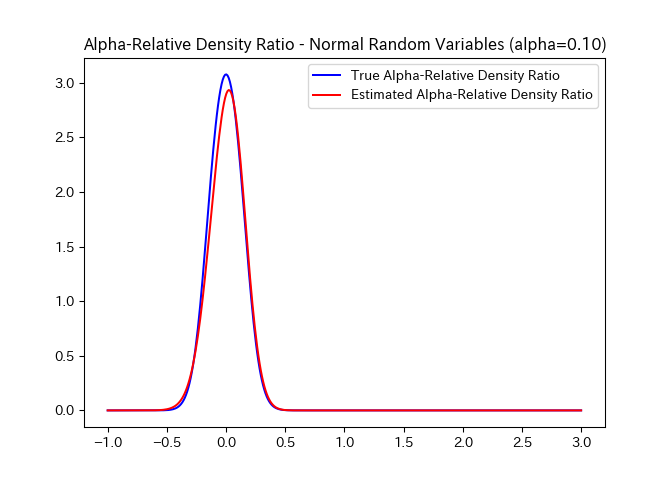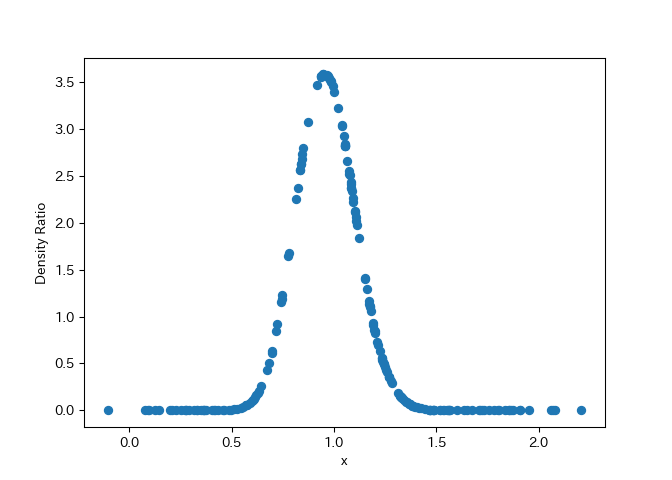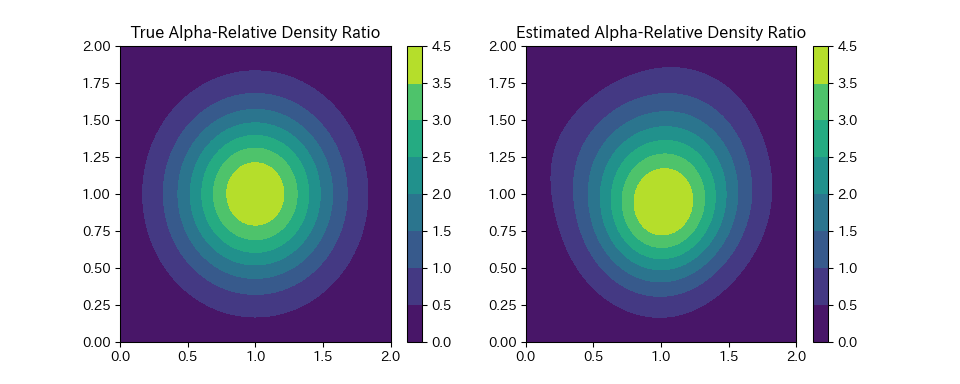Density ratio estimation is described as follows: for given two data
samples x1 and x2 from unknown distributions p(x) and q(x)
respectively, estimate w(x) = p(x) / q(x), where x1 and x2 are
d-dimensional real numbers.
The estimated density ratio function w(x) can be used in many
applications such as the inlier-based outlier detection [1] and
covariate shift adaptation [2]. Other useful applications for density
ratio estimation were summarized by Sugiyama et al. (2012) in [3].
The package densratio provides a function densratio() that returns
an object with a method to estimate density ratio as
compute_density_ratio().
Further, the alpha-relative density ratio p(x)/(alpha * p(x) + (1 - alpha) * q(x)) (where alpha is in the range [0, 1]) can also be
estimated. When alpha is 0, this reduces to the ordinary density ratio
w(x). The alpha-relative PE-divergence and KL-divergence between
p(x) and q(x) are also computed.
For example,
import numpy as np
from scipy.stats import norm
from densratio import densratio
np.random.seed(1)
x = norm.rvs(size=500, loc=0, scale=1./8)
y = norm.rvs(size=500, loc=0, scale=1./2)
alpha = 0.1
densratio_obj = densratio(x, y, alpha=alpha)
print(densratio_obj)gives the following output:
#> Method: RuLSIF
#>
#> Alpha: 0.1
#>
#> Kernel Information:
#> Kernel type: Gaussian
#> Number of kernels: 100
#> Bandwidth(sigma): 0.1
#> Centers: matrix([[-0.09591373],..
#>
#> Kernel Weights (theta):
#> array([0.04990797, 0.0550548 , 0.04784736, 0.04951904, 0.04840418,..
#>
#> Regularization Parameter (lambda): 0.1
#>
#> Alpha-Relative PE-Divergence: 0.6187941335987046
#>
#> Alpha-Relative KL-Divergence: 0.7037648129307482
#>
#> Function to Estimate Density Ratio:
#> compute_density_ratio(x)
#>
In this case, the true density ratio w(x) is known, so we can compare
w(x) with the estimated density ratio w-hat(x). The code below gives
the plot shown above.
from matplotlib import pyplot as plt
from numpy import linspace
def true_alpha_density_ratio(sample):
return norm.pdf(sample, 0, 1./8) / (alpha * norm.pdf(sample, 0, 1./8) + (1 - alpha) * norm.pdf(sample, 0, 1./2))
def estimated_alpha_density_ratio(sample):
return densratio_obj.compute_density_ratio(sample)
sample_points = np.linspace(-1, 3, 400)
plt.plot(sample_points, true_alpha_density_ratio(sample_points), 'b-', label='True Alpha-Relative Density Ratio')
plt.plot(sample_points, estimated_alpha_density_ratio(sample_points), 'r-', label='Estimated Alpha-Relative Density Ratio')
plt.title("Alpha-Relative Density Ratio - Normal Random Variables (alpha={:03.2f})".format(alpha))
plt.legend()
plt.show()You can install the package from PyPI.
$ pip install densratio
Also, you can install the package from GitHub.
$ pip install git+https://github.com/hoxo-m/densratio_py.git
The source code for densratio package is available on GitHub at https://github.com/hoxo-m/densratio_py.
The package provides densratio(). The function returns an object that
has a function to compute estimated density ratio.
For data samples x and y,
from scipy.stats import norm
from densratio import densratio
x = norm.rvs(size = 200, loc = 1, scale = 1./8)
y = norm.rvs(size = 200, loc = 1, scale = 1./2)
result = densratio(x, y)In this case, result.compute_density_ratio() can compute estimated
density ratio.
from matplotlib import pyplot as plt
density_ratio = result.compute_density_ratio(y)
plt.plot(y, density_ratio, "o")
plt.xlabel("x")
plt.ylabel("Density Ratio")
plt.show()The package estimates density ratio by the RuLSIF method.
RuLSIF (Relative unconstrained Least-Squares Importance Fitting) estimates the alpha-relative density ratio by minimizing the squared loss between the true and estimated alpha-relative ratios. You can find more information in Hido et al. (2011) [1] and Liu et al (2013) [4].
The method assumes that the alpha-relative density ratio is represented by a linear kernel model:
w(x) = theta1 * K(x, c1) + theta2 * K(x, c2) + ... + thetab * K(x, cb)
where K(x, c) = exp(- ||x - c||^2 / (2 * sigma ^ 2)) is the Gaussian
RBF kernel.
densratio() performs the following: - Decides kernel parameter sigma
by cross-validation. - Optimizes for kernel weights theta. - Computes
the alpha-relative PE-divergence and KL-divergence from the learned
alpha-relative ratio.
As the result, you can obtain compute_density_ratio(), which will
compute the alpha-relative density ratio at the passed coordinates.
densratio() outputs the result like as follows:
#> Method: RuLSIF
#>
#> Alpha: 0
#>
#> Kernel Information:
#> Kernel type: Gaussian
#> Number of kernels: 100
#> Bandwidth(sigma): 0.1
#> Centers: matrix([[0.92113356],..
#>
#> Kernel Weights (theta):
#> array([0.08848922, 0.03377533, 0.0753727 , 0.06141277, 0.02543963,..
#>
#> Regularization Parameter (lambda): 1.0
#>
#> Alpha-Relative PE-Divergence: 0.9635169300831035
#>
#> Alpha-Relative KL-Divergence: 0.8388266265473269
#>
#> Function to Estimate Density Ratio:
#> compute_density_ratio(x)
#>
- Method is fixed as RuLSIF.
- Kernel type is fixed as Gaussian RBF.
- Number of kernels is the number of kernels in the linear model.
You can change by setting
kernel_numparameter. In default,kernel_num = 100. - Bandwidth(sigma) is the Gaussian kernel bandwidth. In default,
sigma = "auto", the algorithm automatically select an optimal value by cross validation. If you setsigmaa number, that will be used. If you setsigmaa numeric array, the algorithm select an optimal value in them by cross validation. - Centers are centers of Gaussian kernels in the linear model.
These are selected at random from the data sample
xunderlying a numerator distributionp(x). You can find the whole values inresult.kernel_info.centers. - Kernel weights(theta) are theta parameters in the linear kernel
model. You can find these values in
result.theta. - The function to estimate the alpha-relative density ratio is
named
compute_density_ratio().
So far, we have deal with one-dimensional data samples x and y.
densratio() allows to input multidimensional data samples as
numpy.ndarray or numpy.matrix, as long as their dimensions are the
same.
For example,
from scipy.stats import multivariate_normal
from densratio import densratio
np.random.seed(1)
x = multivariate_normal.rvs(size=3000, mean=[1, 1], cov=[[1. / 8, 0], [0, 1. / 8]])
y = multivariate_normal.rvs(size=3000, mean=[1, 1], cov=[[1. / 2, 0], [0, 1. / 2]])
alpha = 0
densratio_obj = densratio(x, y, alpha=alpha, sigma_range=[0.1, 0.3, 0.5, 0.7, 1], lambda_range=[0.01, 0.02, 0.03, 0.04, 0.05])
print(densratio_obj)gives the following output:
#> Method: RuLSIF
#>
#> Alpha: 0
#>
#> Kernel Information:
#> Kernel type: Gaussian
#> Number of kernels: 100
#> Bandwidth(sigma): 0.3
#> Centers: matrix([[1.01477443, 1.38864061],..
#>
#> Kernel Weights (theta):
#> array([0.06151164, 0.08012094, 0.10467369, 0.13868176, 0.14917063,..
#>
#> Regularization Parameter (lambda): 0.04
#>
#> Alpha-Relative PE-Divergence: 0.653615870855595
#>
#> Alpha-Relative KL-Divergence: 0.6214285743087549
#>
#> Function to Estimate Density Ratio:
#> compute_density_ratio(x)
#>
In this case, as well, we can compare the true density ratio with the estimated density ratio.
from matplotlib import pyplot as plt
from numpy import linspace, dstack, meshgrid, concatenate
def true_alpha_density_ratio(x):
return multivariate_normal.pdf(x, [1., 1.], [[1. / 8, 0], [0, 1. / 8]]) / \
(alpha * multivariate_normal.pdf(x, [1., 1.], [[1. / 8, 0], [0, 1. / 8]]) + (1 - alpha) * multivariate_normal.pdf(x, [1., 1.], [[1. / 2, 0], [0, 1. / 2]]))
def estimated_alpha_density_ratio(x):
return densratio_obj.compute_density_ratio(x)
range_ = np.linspace(0, 2, 200)
grid = np.concatenate(np.dstack(np.meshgrid(range_, range_)))
levels = [0, 0.5, 1, 1.5, 2, 2.5, 3, 3.5, 4.5]
plt.figure(figsize=(10, 4))
plt.subplot(1, 2, 1)
plt.contourf(range_, range_, true_alpha_density_ratio(grid).reshape(200, 200), levels)
#> <matplotlib.contour.QuadContourSet object at 0x1a2067f470>
plt.colorbar()
#> <matplotlib.colorbar.Colorbar object at 0x1a22fb04e0>
plt.title("True Alpha-Relative Density Ratio")
plt.subplot(1, 2, 2)
plt.contourf(range_, range_, estimated_alpha_density_ratio(grid).reshape(200, 200), levels)
#> <matplotlib.contour.QuadContourSet object at 0x1a20643550>
plt.colorbar()
#> <matplotlib.colorbar.Colorbar object at 0x1a232486a0>
plt.title("Estimated Alpha-Relative Density Ratio")
plt.show()[1] Hido, S., Tsuboi, Y., Kashima, H., Sugiyama, M., & Kanamori, T. Statistical outlier detection using direct density ratio estimation. Knowledge and Information Systems 2011.
[2] Sugiyama, M., Nakajima, S., Kashima, H., von Bünau, P. & Kawanabe, M. Direct importance estimation with model selection and its application to covariate shift adaptation. NIPS 2007.
[3] Sugiyama, M., Suzuki, T. & Kanamori, T. Density Ratio Estimation in Machine Learning. Cambridge University Press 2012.
[4] Liu, S., Yamada, M., Collier, N., & Sugiyama, M. Change-Point Detection in Time-Series Data by Relative Density-Ratio Estimation Neural Networks, 2013.
- densratio for R https://github.com/hoxo-m/densratio
- pykliep https://github.com/srome/pykliep





